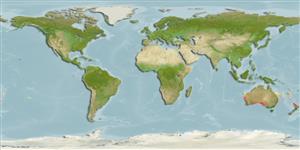Klassifizierung / Names
Namen | Synonyme | Catalog of Fishes (gen., sp.) | ITIS | CoL | WoRMS | Cloffa
Elasmobranchii (Haie und Rochen) (sharks and rays) >
Torpediniformes (Electric rays) >
Hypnidae (Coffin rays)
Etymology: Hypnos: Greek, hypnos = sleep (Ref. 45335).
Lebensraum / Klimazone / Range
Ökologie
; seewasser riff-verbunden; tiefenbereich 0 - 240 m (Ref. 9710). Temperate, preferred ?; 21°S - 38°S
Indo-West Pacific: endemic to Australia.
Length at first maturity / Size / Gewicht / Alter
Maturity: Lm ?, range 24 - ? cm
Max length : 70.0 cm TL Männchen/unbestimmt; (Ref. 2272); common length : 40.0 cm TL Männchen/unbestimmt; (Ref. 6871)
Occurs inshore and offshore, ranging from the intertidal to 240 m depth (Ref. 9910, 12951). Found buried on sand and mud bottoms; sometimes found stranded out of water by the tide but is capable of surviving for hours (Ref. 9910). Feeds on crabs, worms, and fishes. Ovoviviparous (Ref. 50449). A slow-moving species which uses its electric organs to stun prey. Also stuns people when accidentally stepped upon or handled (Ref. 9910). Maximum length probably to 92 cm TL (Ref. 9910).
Life cycle and mating behavior
Geschlechtsreife | Fortpflanzung | Ablaichen | Eier | Fecundity | Larven
Exhibit ovoviparity (aplacental viviparity), with embryos feeding initially on yolk, then receiving additional nourishment from the mother by indirect absorption of uterine fluid enriched with mucus, fat or protein through specialised structures (Ref. 50449). Size at birth 8 to 11 cm TL (Ref. 9910).
Compagno, L.J.V., 1999. Checklist of living elasmobranchs. p. 471-498. In W.C. Hamlett (ed.) Sharks, skates, and rays: the biology of elasmobranch fishes. Johns Hopkins University Press, Maryland. (Ref. 35766)
IUCN Rote Liste Status (Ref. 115185)
CITES (Ref. 94142)
Not Evaluated
Nutzung durch Menschen
Fischereien: nicht kommerziell
Mehr Information
Alter/Größe
Wachstum
Länge-Gewicht
Länge-Länge
Längenhäufigkeiten
Morphometrie
Morphologie
Larven
Larven Pop.Dyn.
Rekrutierung
Dichte
ReferenzenAquakulturAquakultur ProfilZuchtlinienGenetikAllel-HäufigkeitenVererbbarkeitKrankheitenVerarbeitungMass conversion
PartnerBilderStamps, CoinsLauteCiguateraGeschwindigkeitSchwimmstilKiemenoberflächeOtolithsGehirngrößeSehfähigkeit
Tools
Zusatzinformationen
Download XML
Internet Quellen
Estimates of some properties based on models
Phylogenetic diversity index (Ref.
82805): PD
50 = 1.5000 [Uniqueness, from 0.5 = low to 2.0 = high].
Bayesian length-weight: a=0.01000 (0.00244 - 0.04107), b=3.04 (2.81 - 3.27), in cm Total Length, based on all LWR estimates for this body shape (Ref.
93245).
Trophic Level (Ref.
69278): 3.7 ±0.57 se; Based on food items.
Widerstandsfähigkeit (Ref.
69278): .
Verwundbarkeit (Ref.
59153): Moderate to high vulnerability (48 of 100) .
